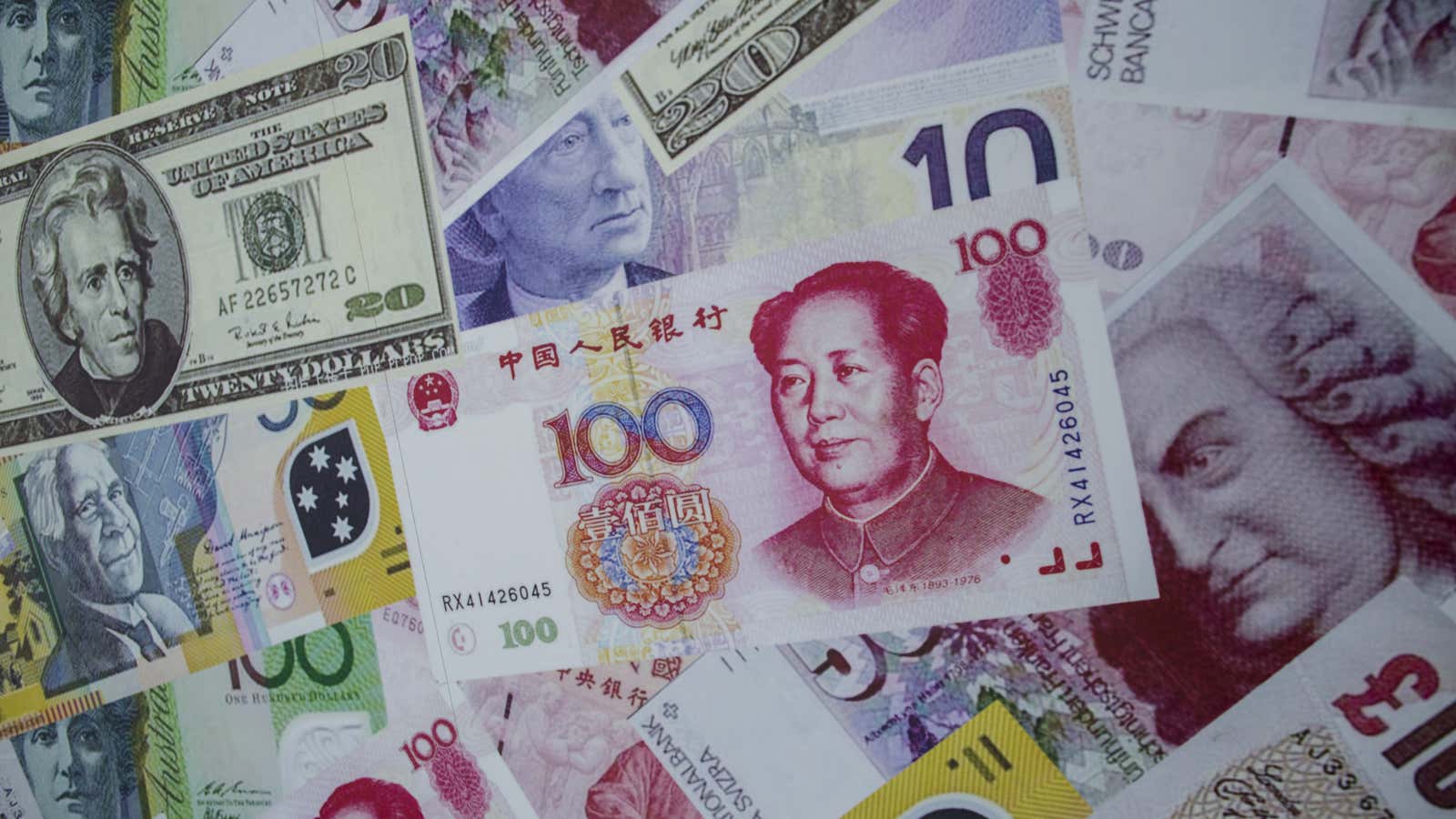Years from now, two seminal events will define 2020: the coronavirus pandemic, and the introduction of China’s digital currency. So says Xu Yuan, a professor of finance at Peking University.
If a digital yuan officially launches, Xu said in an interview in April (link in Chinese), 2020 will be as important in the history of global currencies as 1816, when the gold standard was established, and 1944, when the Bretton Woods system was established and ushered in a new post-war economic world order, with exchange rates pegged to the US dollar, effectively making it the global currency.
That may be ambitious rhetoric, pinning a lot of hope on what a digital version might do for the yuan’s global standing.
It’s true that among all central bank digital currency projects currently under way across the world, China’s is at the most advanced stage, according to the Bank of International Settlements. Six major state-owned banks are now involved in China’s trial, with the People’s Bank of China (PBOC) providing the core infrastructure behind the digital yuan, while commercial banks would provide services to the public, like distributing the currency and executing payments. A pilot program that began earlier this year now covers major cities in the mainland, including Beijing and Shanghai, and will expand to Hong Kong and Macau as well. No firm timeline for a full rollout has yet been made public.
To be clear, this not a cryptocurrency, though it’s sometimes inaccurately referred to as such. Cryptocurrencies refer exclusively to digital units transacted on a decentralized blockchain network, whereas the digital yuan is issued and backed by a central bank.
Beijing has long wanted to boost the yuan’s stature in the global financial system—or “internationalize” the yuan, as the lingo goes. Its limited progress in pursuing that goal—almost 40% of global transactions on Swift are denominated in dollars, compared to less than 2% in yuan—has frustrated Chinese officials. Theoretically, if enough countries adopted the digital yuan for international payment transactions over time, then it could one day challenge the dominance of the US dollar.
That’s unlikely unless China makes drastic changes to how it manages the yuan, virtual or otherwise.
Because the digital currency is little different from the yuan itself, it will on its own “not be a game changer that elevates the renminbi’s role in international finance,” wrote Eswar Prasad, a professor of trade policy at Cornell University, using the currency’s official name. “After all, the Chinese government still restricts capital inflows and outflows, and the People’s Bank of China still manages the renminbi’s exchange rate. Neither policy is likely to change significantly anytime soon.”
What investors are looking for in a reserve currency isn’t the technology—it’s a currency that’s stable, underpinned by a strong economy, freely convertible, and able to be used widely.
Victor Shih, an expert on China’s political economy and a professor at University of California San Diego, explained that merely introducing a digital currency “doesn’t solve the problem that some people holding renminbi offshore will want to sell that renminbi and exchange it for the dollar,” which is widely considered to be a safer asset. Here the gap is even larger: Nearly two-thirds of the world’s currency reserves are held in US dollars, compared with 2% in yuan.
Suppose Iran sold China a large amount of oil, and accepted the digital yuan as payment. That would help with Beijing’s goal of pursuing more widespread use of the yuan in international transactions. But Tehran would probably want to use at least a quarter of those earnings to buy goods from Europe, said Shih, so they would need to convert a portion of the digital yuan into dollars and euros, the second-most used currency for global payments.
“If that happened on a very large scale, you’d have hundreds of billions of renminbi accumulating in Hong Kong,” a major clearing center for yuan-denominated transactions. And if those yuan were converted to another currency in large amounts, “the renminbi will be under downward pressure and the PBOC will have to step in” to prop up its value.
Still, the digital yuan could be one way for the state to try and wrest back control of digital payments from commercial companies, but it’s unclear what that would mean for the two dominant digital wallets, Alipay and WeChat Pay, who handle 94% of electronic payment transactions (link in Chinese). The central bank could theoretically ban commercial wallets like Alipay outright to eliminate competition, Shih said, but “that would be pretty terrible.”
One key advantage of people using digital yuan, Shih said, is enabling China’s central bankers to track exactly where every yuan is going in greater detail than possible at present. If Iran made purchases with its digital yuan earnings, for example, the PBOC would be able to see what it’s bought, and from whom, down to the cent. Yet the same thing that makes a virtual currency attractive to China’s government could work against it elsewhere—there are lots of situations when even perfectly law-abiding people don’t want governments to know what they’re doing, particularly when that government is the Communist Party of China.
Shih does see one potential opportunity: weaving the digital yuan into a payment systems on platforms like TikTok, the viral video app owned by Chinese tech giant ByteDance and boasting hundreds of millions of users, or in popular video games like Fortnite, developed by Epic Games, which is 40%-owned by Chinese tech firm Tencent.
“That’s the thing about the digital world,” said Shih. “Everything is potentially linkable so you can leverage popularity on one platform to get popularity on another platform.”




